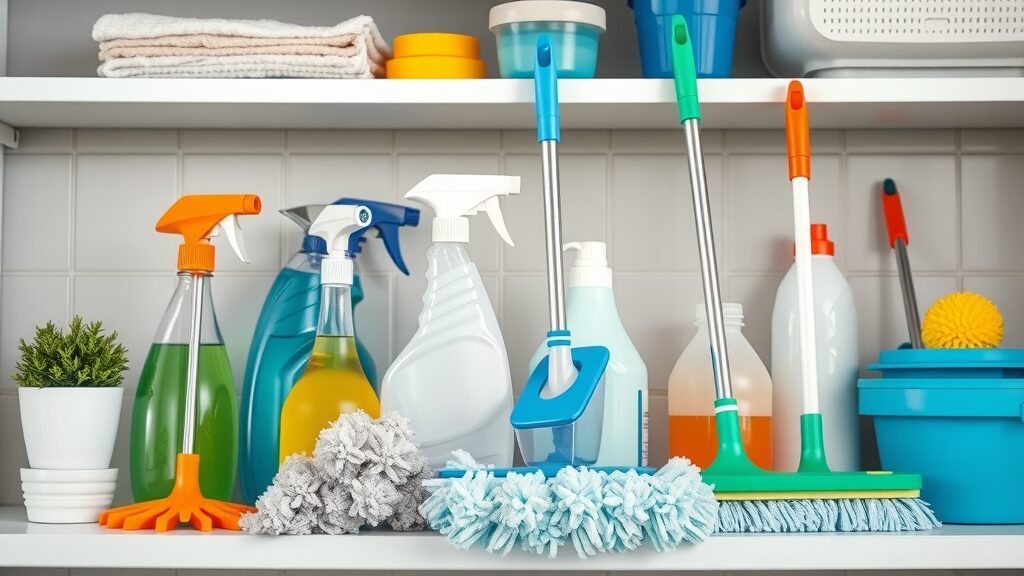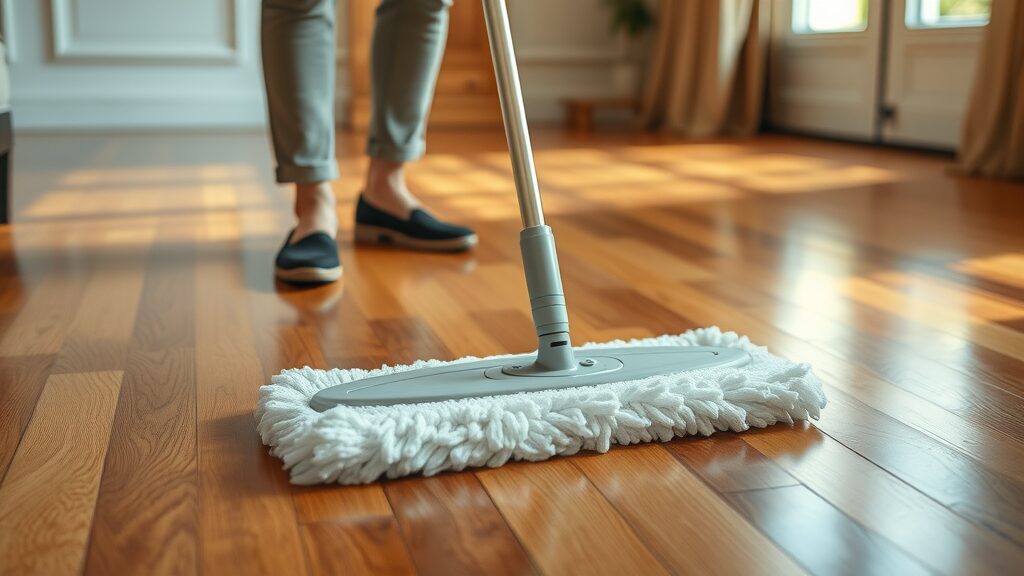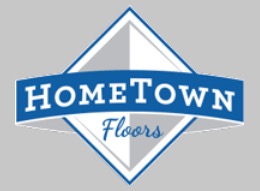
“Did you know that regular floor maintenance can extend your flooring’s lifespan by up to 50%? This flooring maintenance guide reveals expert-backed facts and simple techniques to keep your floors looking new.”
Keeping your floors in pristine condition isn’t just about curb appeal—it’s a proven way to protect your investment, avoid costly repairs, and ensure your home feels clean and healthy every day. In this flooring maintenance guide , you’ll discover practical care tips, routines, and the most effective cleaning products for every major floor surface. Whether you have hardwood, vinyl plank, carpet, or tile, this comprehensive care guide empowers you with daily, weekly, and monthly steps to keep floors looking flawless, fast. Read on to unlock expert-backed strategies that truly extend the life of your floor and make maintenance effortless.
Flooring Maintenance Guide: Why Proper Floor Care Matters
Consistent floor maintenance is one of the easiest ways to enhance durability and beauty in every room of your home. According to flooring industry research, neglected floors can lose their finish, accumulate permanent stains, or even pose safety hazards due to warping and loose boards. On the flip side, homes that follow a precise care guide tend to maintain flooring for years longer, all while reducing allergens and preventing uneven wear. Proper care goes beyond just making your floor look clean—it’s about taking steps that truly protect your investment, making everyday upkeep a breeze and enhancing your home’s value.
Here’s why you should never skip floor care: regular cleaning prevents the buildup of dirt and grime that can scratch, dull, or stain your floor surface. Spills that aren’t quickly addressed can seep into cracks, causing warping (on wood floors) or mildew (on carpets). Even safety can be affected, as slick grime or loose floorboards may increase slip hazards. With this flooring maintenance guide , you’ll quickly see how vital—and simple—routine care can be.
- Startling industry facts about flooring longevity and damage
- Benefits of consistent floor maintenance
- How neglect can impact both appearance and safety
| Floor Surface | Common Problems | Basic Care Steps | Frequency | Recommended Products |
|---|---|---|---|---|
| Hardwood | Scratches, dullness, water stains | Dust mop or sweep, spot clean, damp mop with wood floor cleaner | Daily/Weekly | pH-neutral wood floor cleaner, microfiber mop |
| Vinyl Plank | Scuffs, dullness, lifting seams | Sweep/vacuum, damp mop, spot clean with mild solution | Weekly | Vinyl floor cleaner, soft mop |
| Tile & Grout | Mildew, grout stains, cracked tiles | Sweep, damp mop, spot clean grout | Daily/Weekly | Ceramic tile cleaner, grout brush |
| Carpet | Stains, odor, wear spots | Vacuum, spot clean, deep clean | Weekly/Monthly | Carpet shampoo, stain remover, vacuum |
| Laminate Flooring | Swelling, scratches, fading | Dry sweep, damp mop, avoid excessive water | Weekly | Laminate floor cleaner, microfiber mop |

Essential Steps in a Flooring Maintenance Guide: Care for Your Floor Surface
Every floor surface requires a specialized approach to shine and last for years. This section of the flooring maintenance guide delivers step-by-step routines based on frequency—daily, weekly, and monthly—so you can tackle dirt and damage before they take hold. Establishing smart cleaning routines helps avoid harmful build-up, from dust and grit to spills and stains, which can compromise both the appearance and structure of your floors. By committing to regular, easy-to-follow maintenance, you’ll see fewer scratches and less dullness—and enjoy a home that feels fresh from top to bottom.
Routine tasks range from dust mopping with a properly treated dust mop to deeper care like spot cleaning problem areas and checking for early signs of wear and tear. Using the right methods—and referencing this care guide for each surface—ensures your floors remain resilient and visually stunning. Stick to the recommended schedule, and you’ll also minimize allergens and get ahead of problems before they require expensive repairs.
Routine Floor Maintenance: Daily, Weekly, and Monthly Care Tips
An effective floor maintenance strategy breaks down into simple, high-impact routines. For most homes, the foundation is daily sweeping or dust mopping for high-traffic zones—especially for wood floor and laminate flooring, where grit can easily scratch the surface. Use soft-bristle brooms or microfiber mops designed to remove dust and dirt efficiently. Weekly care for tile and vinyl means mopping with a damp, not wet, mop and using a mild floor cleaner . For carpets, weekly vacuuming and prompt spot cleaning of spills keep fibers looking new.
Monthly, take time to inspect floor surfaces for signs of damage: look for dullness, scratches, or warped boards, particularly in places with lots of foot traffic. This is also the time to deep clean tile grout or, for carpets, perform a steam-clean or use specialized cleaning products for a refreshed surface. By proactively sticking to a calendar of daily sweeping, weekly mopping, and monthly checks, you’ll be miles ahead of most when it comes to extending the life of your floor.
- Daily sweeping and dusting methods for each floor surface
- Weekly mopping strategies—dos and don’ts
- Monthly maintenance checks to spot issues early
Best Products and Tools for Floor Maintenance by Floor Surface
No flooring maintenance guide is complete without addressing the crucial role of proper tools and cleaning products. Hardwood and laminate flooring benefit from soft microfiber dust mops and pH-neutral floor cleaner , as harsh chemicals or excessive moisture can ruin the finish manufacturer’s coatings. For tile and grout, use a tile-specific cleaner and a grout brush to eliminate buildup without scratching. Meanwhile, vinyl plank floors call for gentle mopping with a non-abrasive cleaner, while carpets respond best to a high-suction vacuum and targeted stain removers for spot cleaning.
Using the wrong cleaning solution or mop can do more harm than good: wood floors exposed to wet mops may warp; abrasive products can scratch sensitive laminate or vinyl finishes. Always check manufacturer recommendations, especially if your floors have a specialty floor finish. By choosing the right cleaners and tools—a specific care practice for each surface—you’ll protect your floor’s integrity and maximize beauty with every clean.
- Choosing the right cleaners and tools for hardwood, vinyl, tile, and carpet
- How using the wrong products affects floor surfaces
Floor Surface-Specific Care Guide: Tips for Wood, Vinyl, Tile, and More

Hardwood: Floor Maintenance Techniques and Pro Payoff
Hardwood floors are coveted for their timeless appeal, but they demand careful, regular maintenance to look their best. Start with daily dusting using a microfiber mop or a properly treated dust mop to collect dust and dirt that can act as abrasives. Never allow wet spills to linger— spot clean immediately with a slightly damp cloth and dry thoroughly. It’s essential to avoid generic and ammonia-based cleaners, as these can strip your floor finish or void the finish manufacturer’s warranty.
For weekly care, use a damp mop with a pH-neutral wood floor cleaner formulated for the type of finish you have. Too much water can cause your wood floor to swell, so make sure the mop is just slightly damp, not wet. Monthly, inspect for scratches, dull spots, or signs of water damage—prompt repair prevents minor problems from escalating. When in doubt, consult a professional about rejuvenating or re-oiling hardwood to protect your investment for the long haul.
Vinyl Plank: The Best Flooring Maintenance Guide for Easy Care
Modern vinyl plank floors are popular for their resilience, yet regular up-keep is still crucial for a spotless appearance. Their top wear layer does fend off minor abrasions, but grit and sand can quickly cause dullness or scuffs if not promptly addressed. Vacuum or sweep daily, focusing especially on entryways and high-traffic zones where debris tends to accumulate. To maintain the floor surface , use a soft mop and a cleaner specifically formulated for vinyl—avoid wax-based polishes or steam cleaners, which degrade vinyl plank adhesives.
Damp mop as needed, ensuring the mop isn’t soaked—too much moisture can cause the planks to lift or warp at the seams. If you notice tough stains, spot clean with a diluted solution of mild dish soap and water. For preventive maintenance, use felt pads on furniture feet and place mats in heavy-use areas. With this care guide, vinyl plank flooring remains attractive and worry-free for years.
Tile and Grout: Floor Care Guide for Sparkling Surfaces
Tile is a durable favourite in kitchens and bathrooms, but its longevity hinges on regular, surface-specific care. Sweep or vacuum daily to keep dust, dirt, and debris from scratching shiny glaze. When mopping, choose a tile-safe cleaner and wring out the mop well—excess water can cause grime and mildew to build up in grout lines. For sparkling results, pay special attention to spot cleaning grout stains with a dedicated grout brush or homemade mix (baking soda and water).
Tackle monthly deep cleans of grout to prevent discoloration and maintain a pristine look throughout the life of your floor. Replace cracked tiles and repair crumbling grout promptly to avoid more extensive damage. With a vigilant approach and this care guide’s practical tips, tile flooring stays brilliant and resilient, even in busy homes.

Carpet: Maintenance Steps for a Cleaner Floor Surface
Carpet delivers comfort and warmth but requires routine cleaning to prevent matting, stains, and unhealthy build-up of allergens. Begin with thorough vacuuming at least weekly, using slow, overlapping strokes in high-traffic corridors and living areas to ensure you remove dust and dirt from deep within the pile. When stains or spills occur, act fast— spot clean by blotting (not rubbing) with a specialty carpet stain remover, following label instructions for your carpet type.
Monthly, consider using a carpet shampooer or steam cleaning machine to deep clean and deodorize. Rotate furniture periodically to prevent uneven wear patterns and protect high-traffic zones with area rugs or runners. This targeted, specific care approach for carpets enhances their appearance, extends longevity, and maintains a healthier indoor environment.
Common Floor Maintenance Mistakes and How to Avoid Them
Even the most well-intentioned home caretakers make floor maintenance mistakes that can shorten the life of your floor. One of the biggest blunders is using a wet mop or incorrect cleaning solutions on sensitive surfaces like wood and laminate—too much water leads to swelling, warping, and finish peeling. Similarly, skipping regular maintenance in high-traffic areas creates visible wear patterns and permanent discoloration, especially on carpet and vinyl plank.
Other frequent errors include not installing protective pads under chairs and furniture or letting food and liquid spills remain unaddressed for too long, which causes unsightly stains and can even harbor odor-causing bacteria. Follow this flooring maintenance guide to avoid these common pitfalls, relying on prevention and rapid response for every spill, scratch, or scrape.
- Using too much water or wrong cleaning solutions
- Ignoring high-traffic zones
- Skipping protective pads
- Letting spills sit too long
Expert Advice: Floor Maintenance Care Tips for High-Traffic Areas
Hallways, entryways, and family rooms handle the bulk of daily foot traffic—making them prime candidates for specialized care tips. Begin by placing quality doormats both inside and outside entrances to trap dirt and sand before it reaches your floor surface . Shoe-free policies and regular vacuuming or sweeping dramatically extend floor finish and reduce the need for aggressive cleaning products.
Adopt seasonal cleaning routines as weather changes—deep clean in spring, and consider waxing or refreshing wood and vinyl in fall for added resilience through the winter. For families with kids or pets, focus on spot cleaning and selecting protective area rugs and stain-resistant pads. The most effective care guide for these spaces prioritizes prevention and frequent attention.
- Entryway and hallway protection
- Seasonal cleaning routines
- Pet and kid-friendly floor surface strategies

How to Troubleshoot and Repair Floor Surface Issues
Even with the best care, floor issues like scratches, stains, and warping can occur. For small scratches on wood floors, use a colored wood filler or wax stick to blend and seal unsightly marks. On vinyl, replace damaged planks when seams begin to lift, and spot clean persistent scuffs with gentle cleaners. If you encounter stains on tile or grout, try a mixture of baking soda and water or a specialty grout cleaner, scrubbing lightly with a brush.
Carpet repairs might mean patching damaged sections or deep cleaning recurring stains with a robust stain remover or steam cleaner. When repairs exceed basic DIY solutions or extend to structural concerns—such as widespread warping or recurring water intrusion—call a professional. Save time, money, and maintain your floor’s warranty by recognizing when expert help is required.
- Identifying scratches, stains, and warping
- Simple repair solutions and when to call a professional
Proven Floor Maintenance Guide: Extending the Life of Your Floors
Extending the life of your floor starts with proactive, long-term strategies woven throughout your daily, weekly, and annual routines. Use protective mats and area rugs in entryways and under furniture to minimize direct impact on the floor surface. Felt pads applied to the bottoms of chairs, tables, and other heavy items prevent scratches and gouges, especially on wood and laminate floors. Stability in indoor humidity levels is essential for wood and engineered flooring, so consider using a humidifier or dehumidifier to guard against cracks and swelling.
Establish a maintenance calendar to track deep cleans, professional treatments, and routine touch-ups for all surfaces in your home. By following the correct care guide for each material and taking preventive steps, your entire home will benefit from floors that stay vibrant and structurally sound for years to come.
- Protective mats and furniture pads
- Humidity control
- Long-term maintenance calendar

Frequently Asked Questions About Flooring Maintenance Guide and Floor Care
What is proper maintenance of a floor?
- Answer: Proper floor maintenance includes regular cleaning, prompt spill response, correct cleaner selection, and periodic inspections tailored to each floor surface type. This ensures the longevity and beauty of your flooring while preventing damage and costly repairs.
How do you maintain the floors?
- Answer: Maintain floors by removing debris daily, following specific care routines by floor surface, and scheduling deep cleans every season. Adapting your methods for hardwood, vinyl plank, tile, or carpet ensures a clean, safe, and inviting home.
What is the best way to care for vinyl plank flooring?
- Answer: Sweep or vacuum frequently, mop with a damp microfiber mop, avoid abrasive or steam cleaners, and promptly clean up spills. Felt pads under furniture and regular entry mat cleaning also help preserve your vinyl floor surface.
What are the 5 procedures in cleaning floors?
- Answer: 1) Remove surface debris, 2) Dust or sweep, 3) Spot clean stains, 4) Mop with appropriate cleaner, 5) Allow to dry and inspect for issues. This comprehensive care guide keeps floors in peak condition year-round.
Top Takeaways from the Flooring Maintenance Guide: What Makes Great Floor Care
Consistent routines deliver the most powerful results—daily, weekly, and monthly steps prevent dirt, damage, and dullness. Always use the correct care guide for each specific floor surface, as personalized care tips are key to extending the life of your floor . Prevention—through mats, pads, and timely cleaning—will protect your investment for years. When advanced repairs arise, professional help ensures your beautiful floors are restored, not replaced.
- Consistent routine matters most
- Use correct care guide for each floor surface
- Prevention extends life
- Professional help has its place
“Your floors are an investment – with the right flooring maintenance guide, every room in your home can shine for years to come.”
Ready for Flawless Floors? Choose Professional Floor Maintenance and Care
- Get quality flooring and 5-star service—call HomeTown Floors today at (636) 244-4951 or book online at www.hometownfloorsonline.com !
What You’ll Gain by Mastering the Flooring Maintenance Guide
- Confidence in caring for any floor surface
- Savings on repairs and replacements
- Knowledge of the industry’s best care guide
- A cleaner, healthier home
Take action today: Master these floor maintenance steps and invest in your home’s long-lasting beauty and comfort!
Maintaining your floors is essential for preserving their beauty and longevity. For comprehensive care instructions, consider the “Flooring Care Guide” by Centex, which offers detailed maintenance tips for various flooring types, including carpet, tile, vinyl, and wood. ( centex.com ) Additionally, the “Floor Care Guide: Cleaning & Maintenance Instructions” from Lumber Liquidators provides practical advice on daily and long-term care routines to keep your floors looking their best. ( lumberliquidators.com ) These resources will equip you with the knowledge to effectively maintain your floors and protect your investment.


Leave a Reply